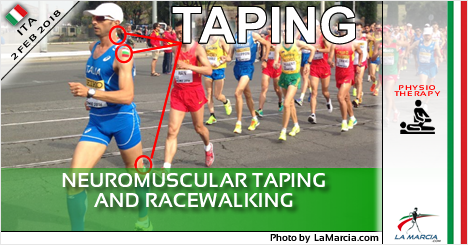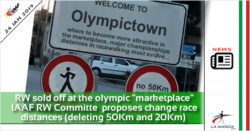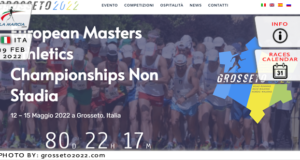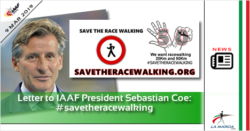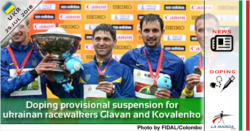The Neuromuscular Taping, better known as “colored patch”, is now almost a fixed presence on the skin of athletes, and of course also of racewalkers. You can see patches of all colors, cut in the strangest ways and applied to every part of the body. Is justa a fad or is really effective? The answer, as far as I am concerned, is really effective.
In the daily work I do in the studio, with athletes and not, it is a valid support in the resolution of some pains, in the optimization of physiotherapy and osteopathic treatment, and in postural correction through proprioceptive stimuli. Take care however, not by chance I used the word “support”; obviously it can not be the only solution to a problem. Neuromuscular taping, devised in Japan, is a mechanical and proprioceptive corrective technique that promotes proper neuromuscular and joint activation as well as improved blood and lymphatic circulation in the pain area.
What is the neurophysiological mechanism at the base of its functioning?
Tactile stimulation of the tape on the skin activates a pain inhibiting system, which leads to the production of a neurotransmitter (enkephalin), resulting in a decrease in pain perception.
The different colors correspond to different ways of use?
The diversity of color does not correspond to a variation of the therapeutic effect, even if there are some studies that are considering the greater effectiveness with respect to the color used (chromotherapy).
What are the characteristics of the tape?
It is a tape absolutely drug-free, waterproof, hypoallergenic and breathable. It has an elasticity of 40-50% and can be used for several days up to a week.
Neuromuscular taping is used in sports before and during athletic engagement, to prepare and prevent, and after, to deflate. In fact it is effective:
At the muscular level
• Improve contraction
• Reduces muscle fatigue
• Reduces excessive muscle extension and contraction
• Reduces cramps and possible muscle injury
• Increase the ROM (amplitude of movement)
• Relieves pain.
At the circulatory level
• Improves blood and lymphatic circulation
• Reduces excess heat and chemicals in tissues
• Reduces inflammation
At the articular level
• In some cases it is compared to a mobile guardian
• Improve the ROM
• Provides joint stability
In the world of heel and toe, together with our Italian national team racewalker Marco De Luca, we were among the first (but perhaps the first …) to apply it during a competition, and specifically we talk about the World Championships in Berlin 2009.
In the period before the race, in a federal training camp, with Marco we experimented the use of neuromuscular taping at the level of the trapezius muscle, to maintain a good level of decontraction of the shoulders and upper limbs for as long as possible, so that the its action remained, even with the increase of fatigue and kilometers, effective and fluid. The results were excellent, so much so that Marco still uses neuromuscular taping in the race.
To conclude, below, you will find some of the most frequent and most useful taping applications for a walker.
FRONT TIBIAL
The tibialis anterior is among the most stressed muscles in racewalking and often can go to annoying tendinitis. In these cases, neuromuscular taping is very indicated, together with other treatments, to solve the inflammatory pathology.
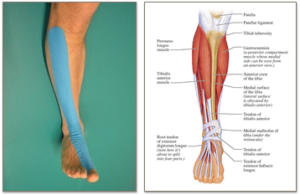
SUPERIOR TRAPEZIO
It is especially recommended for 50km specialist athletes. This application allows, with the increase of km, to maintain a good level of decontraction of the shoulders and upper limbs, having a positive effect on the technical gesture and also on the respiratory efficiency.
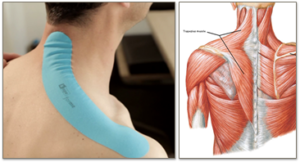
ILEOPSOAS
A good efficiency of this muscle is important in racewalking above all for the action it has on the trunk, since flexes and tilts it from the same side, and rotates it from the opposite side. It is easy to understand, looking at the anatomical image, how a tension of this muscle can negatively affect the mobility of the lumbar region and the pelvis, and therefore of the specific technical gesture of the racewalking.
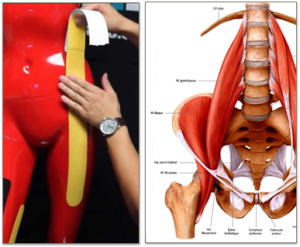
GASTROCNEMIO AND SOLEO
The gastrocnemius together with the soleus, besides being important muscles for the action they have on the foot, on the ankle and on the knee, represent the so-called “venous pump” of the lower limb, which ensures a correct return of the venous blood to the heart. The taping shown in the image below, is in “draining” mode, so it is very suitable in a recovery phase and in post training. It is not suitable for competition.
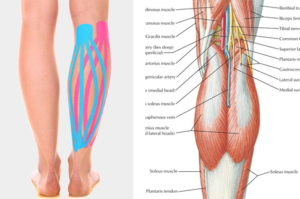
Dr. Cristian Bruno
Osteopath D.O.
Physiotherapist of the Italian Athletics National Team
www.cristianbruno.it
